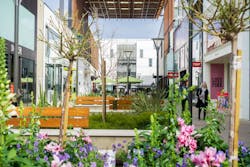The Future of Architecture Lies in Fluid Design
The future of architecture will discard previous notions of fenced-in spaces meant solely for work and life. Spaces will transform into fluid, shared, and multi-functional areas where single purpose places, such as offices, are no longer necessary, says Forbes. J.F. Finn, principal at Gensler, says now is the time where socioeconomic and geopolitical cycles collide to create a shift in thought around the built environment. The pandemic pushes the idea of barriers and what effective real estate means, he continues. And at a time where more housing is needed, this new perspective on architecture can make a significant impact.
Jane Greenthal is an associate principal of planning and strategies at the global architecture firm Perkins&Will and agrees that the keys to increased density are legislative change and economic feasibility, which both have to be in place before starting the design.
Greg Willett, chief economist at real estate software company RealPage, points out the critical need for more development density to boost housing supply. RealPage information shows that about 50% of all the apartments under construction across the US are in mid-rise properties, while 30% of the near-term additions will be high-rise projects, and 20% will come in low-rise communities.
Mixed-use developments, especially those that incorporate appealing open spaces in their design, are one component of the needed array of product, Willett says.
